
We are celebrating 15 years — and counting — of stories that are deeply researched and deeply felt, that build a historical record of what the city has been.
We are celebrating 15 years — and counting — of stories that are deeply researched and deeply felt, that build a historical record of what the city has been.
Despite the impulse to marvel at Hong Kong’s sophisticated planning for and investment in infrastructure and urban density, might people there welcome some New York-style urbanism? Norman Oder, author of the watchdog blog Atlantic Yards Report, recaps two conferences that suggest that New York’s mechanisms for community input on development projects, imperfect as they are, may themselves be worthy of a little envy from concerned citizens facing top-down urban planning regimes. –C.S.
UPDATE, 8.21.2010: please see the comments for an important clarification from the author.
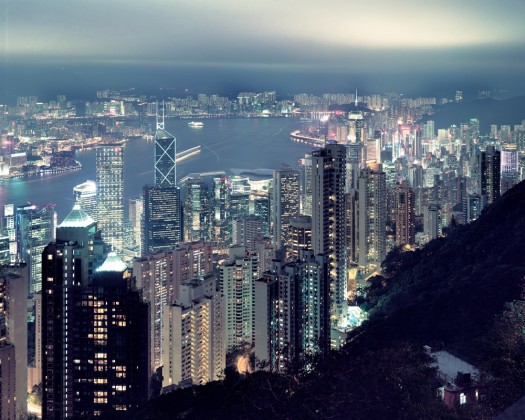
Hong Kong. Photo by Flickr user Thomas Birke.
In his “A Country of Cities” series on Urban Omnibus, Vishaan Chakrabarti recently described how he “attended a terrific conference on vertical density in Hong Kong.” The city-state, he suggested, has mastered the infrastructure challenge. He wrote:
I hadn’t visited in over a decade, and in that time more density has been built, a few more skyscrapers dot the stunning skyline, but the advances one really notices are on the ground. The new airport. The 20-minute train from the airport to downtown. The gleaming subways that glide under Victoria Harbor from Kowloon to Central. The stunning new bridges and tunnels. The lush country parks.
His argument presents examples that might rightly inspire New Yorkers and Americans to clamor for longer-range investment in infrastructure. Why doesn’t New York have a one-seat ride from its airports? Why shouldn’t high-speed rail connect Boston, New York, and Washington, DC?
Still, a notable irony was evident at two conferences organized by The Skyscraper Museum, Vertical Density/Sustainable Solutions, held in New York in October 2008, and Vertical Density: the Public Dimension, held this past January in Hong Kong. While Chakrabarti and other New Yorkers enthused about Hong Kong’s advances, many from Hong Kong worried about the cost of progress. As one top Hong Kong official observed in January, “People are complaining… enough is enough.”
At both conferences, those from Hong Kong invoked our city’s appreciation of history (or, to them, heritage), diversity of building types, avoidance of superblocks, rich street life, and relatively robust opportunity for citizen input. As became clear, density in Hong Kong was fostered by cultural, economic, and historical factors not present in recent-day New York, including top-down planning, warp-speed growth (driven by an influx of refugees from Communist China), an empowered mass transit agency, and a disengaged citizenry.
So while there’s a good argument to build residential density in New York — our city’s towers are primarily commercial — as well as infrastructure, the lessons from Hong Kong may be more aspirational than direct. (Metropolis columnist Karrie Jacobs, who covered the first conference, also teased out the contradictions in a December 2008 column headlined Boomtown Blues.)
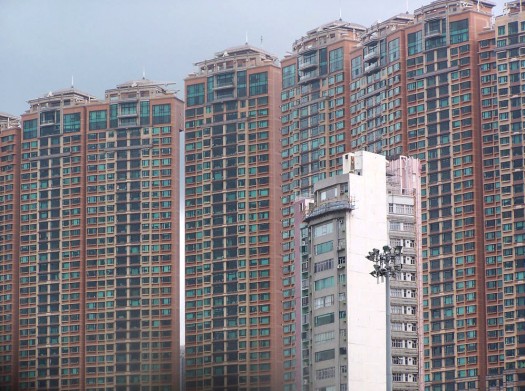
Hong Kong. Photo by Flickr user Photocapy.
The Hong Kong scene
Hilly and mountainous, more than three-quarters of Hong Kong territory is preserved as natural landscape, so the city-state has been forced to grow vertically. Complementing the dense central areas on Hong Kong Island, transit-based development creates cross-harbor New Towns out of dozens of identical apartment towers, typically 50-plus stories surrounding a shopping mall. Eminent domain is freely used, and the tax structure militates against warehousing land.
Given the constraints, there was no postwar suburbia to build, as in New York; there was no opportunity, as in New York, to have downzonings privilege wealthier transit-accessible low-rise neighborhoods while upzonings transformed their working-class counterparts, as New York University’s Furman Center for Real Estate and Urban Policy recently found (PDF).
Hong Kong’s thicket of towers has produced a system of upper-level walkways with their own retail and corridor life. Not that it’s fully beloved. While Hong Kong may be the freest economy in the world, “when it comes to pedestrian movement, [it] is one of the least free places in the world,” observed urban designer Oren Tatcher in January.
Hong Kong’s growth has been driven significantly by its transit system, the MTR (Mass Transit Railway), founded in 1975. The MTR (once a public company, now private) acts as a master developer to insure integration of property with the railway, explained Thomas Ho, MTR Property Director, to rapt listeners at the New York conference.
Carrie Lam, since July 2007 Secretary for Development of the Hong Kong Special Administrative Region Government, explained that leveling mountains and reclaiming the harbor created the old airport’s runway, the entire new airport, and parts of the Central Business District. “The harbor is unlikely to argue with you whether it is right or not to reclaim from the harbor,” she said at the New York conference.
That statement pricked up New York ears. Here, “building something in the water today in New York is virtually impossible for a variety of political and environmental reasons,” observed Christopher Ward, executive director of the Port Authority of New York and New Jersey.
American admiration
American respondents in New York expressed admiration for Hong Kong’s embrace of high-rises and the MTR’s ability to plan rationally. “There’s a dystopia associated with skyscrapers that we need to address,” suggested Ward, citing movies like Blade Runner.
Chakrabarti, then executive VP of the Related Companies, observed, “I think what we’ve seen today should make us, as New Yorkers, very humble, and should really give us pause.” While Americans reject “the culture of density,” he suggested that the real dystopia is evoked by movies like The Stepford Wives, which convey a “very isolated, scary, and fuel-inefficient suburban model.”
A veteran of the effort to build a Moynihan Station that would combine a new train station with mixed-use development, Chakrabarti said we should be “less scared” of public-private partnerships and should “capture land use value around train stations.”
The intangibles
That’s what they’ve done in Hong Kong, to an extent perhaps unique around the world. High-rise living, Ho suggested, can be achieved “in a very civilized way; it all depends on how you plan.”
But most units are smaller than 750 square feet. “We’re living in shoeboxes at extremely high density,” lamented architect Keith Griffiths at the follow-up conference. Local developer Keith Kerr added: “I’m all for building density around railway points, but we end up with a city that’s planned by a railway line.”
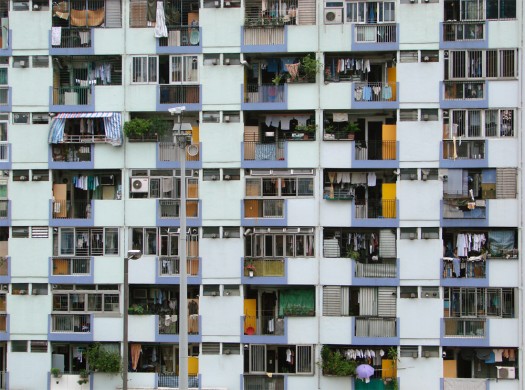
Kowloon Housing. Photo by Flickr user Photocapy.
People in Hong Kong, suggested real estate consultant Nicholas Brooke, pragmatically accept vertical living, though some New Towns residents have experienced “family feuds, suicides, things that build up from pressure from living in high-rise towers.” While planning “was very much driven by engineers” and an effort to maximize land revenues, now there’s a growing sense that intangibles should be considered, Brooke said.
Hong Kong’s functionalism, added Peter Cookson Smith, an architect, city planner and urban designer, is “producing an undifferentiated city form of standard blocks” in contrast to the diversity in New York that “simply takes your breath away.”
Christine Loh, CEO of the think tank Civic Exchange, showed pictures of Hong Kong people going through their daily activities. “How do we preserve the feel of these places?” She and others expressed admiration how issues like landmarking have been translated into New York’s policy. She also cited universities and think tanks as examples of a “tremendous civil society and engagement.”
Hong Kong matures
Secretary for Development Lam, in New York, suggested that, as Hong Kong’s growth has slowed, planners have more of a “luxury” to address issues like building height and bulk and the lack of street life. She described an intensive public planning process for the old airport site at Kai Tak in which more parks emerged, thanks to “an extensive reduction in density.”
Later, at the Hong Kong conference, Lam was more emphatic, asserting that, as much as possible, “We should balance redevelopment with building rehabilitation, revitalization, and preservation of some of our historic past.”
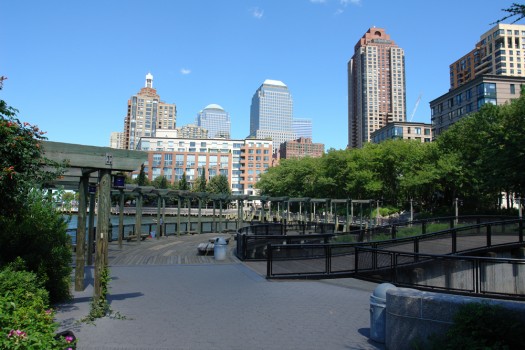
Battery Park City. Photo by Flickr user MD111.
Solutions in New York
Of course Hong Kong and New York have been traveling along different paths. Chakrabarti, in Hong Kong, suggested it was dangerous to compare the two cities’ responses to density, given that New York is “a city that may be very dense at its center, but is extraordinarily sprawling as a region.” And he pointed out that a “mature” city like London also surpasses New York in building infrastructure.
“It’s very difficult to build and finance infrastructure if you don’t believe in central authority,” Chakrabarti said, a hint at the regional inequities he’s highlighted.
It’s hard to disagree, as the main challenge remains regional and national. Still, New York’s record suggests that, even within the city, the rational planning process can be distorted. Consider how the Furman Center suggested fairness has been scanted in the city’s rezonings.
Or consider how the Port Authority’s Ward, at the New York conference, suggested that the resistance to the massive Atlantic Yards project in Brooklyn stemmed from locals’ discomfort with a dramatic shift in density. While that shift surely generated dismay, an equal measure of discomfort derives from the perception that Atlantic Yards has been a sweetheart deal, with a single developer anointed public land before any planning process, and with public amenities such as open space coming late rather than early.
Chakrabarti observed that communities will accept density only if the infrastructure is there first; indeed, a showcase New York example at the Hong Kong conference was Battery Park City, with its parkland frontloaded and parcels bid out to multiple developers, though it was acknowledged that original goals for affordable housing were not met.
A former director of the Manhattan office of the Department of City Planning turned developer turned academic, Chakrabarti knows New York’s constraints: “We cannot generate amenities, open space, even simple improvements to the subway system without harnessing new development.” If so, as in Hong Kong, it’s important to get the balance right between the development business and the central authorities entrusted with the public interest.
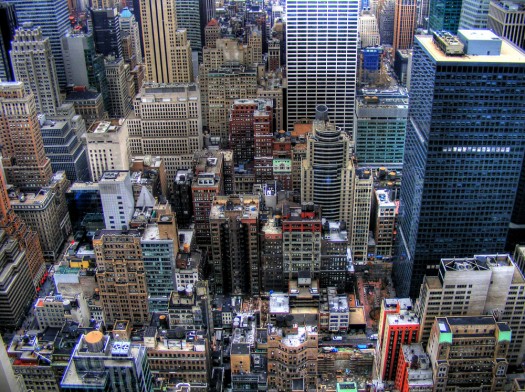
New York City. Photo by Flickr user Christopher Isherwood.
The views expressed here are those of the author only and do not reflect the position of Urban Omnibus editorial staff or the Architectural League of New York.
The views expressed here are those of the authors only and do not reflect the position of The Architectural League of New York.
Comments